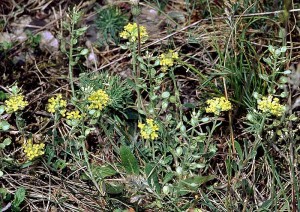Researchers on a £3 million research programme called “Cleaning Land for Wealth” (CL4W) are confident they’ll be able to use flowers and plants to clean soil of poisonous materials (environmental remediation) and to recover platinum (phyto-mining). From the Nov. 21, 2012 news item on Nanowerk,
A consortium of researchers led by WMG (Warwick Manufacturing Group) at the University of Warwick are to embark on a £3 million research programme called “Cleaning Land for Wealth” (CL4W), that will use a common class of flower to restore poisoned soils while at the same time producing perfectly sized and shaped nano sized platinum and arsenic nanoparticles for use in catalytic convertors, cancer treatments and a range of other applications.
The Nov. 20, 2012 University of Warwick news release, which originated the news item, describes both how CL4W came together and how it produced an unintended project benefit,
A “Sandpit” exercise organised by the Engineering and Physical Sciences Research Council (EPSRC) allowed researchers from WMG (Warwick Manufacturing group) at the University of Warwick, Newcastle University, The University of Birmingham, Cranfield University and the University of Edinburgh to come together and share technologies and skills to come up with an innovative multidisciplinary research project that could help solve major technological and environmental challenges.
The researchers pooled their knowledge of how to use plants and bacteria to soak up particular elements and chemicals and how to subsequently harvest, process and collect that material. They have devised an approach to demonstrate the feasibility in which they are confident that they can use common classes of flower and plants (such as Alyssum), to remove poisonous chemicals such as arsenic and platinum from polluted land and water courses potentially allowing that land to be reclaimed and reused.
That in itself would be a significant achievement, but as the sandpit progressed the researchers found that jointly they had the knowledge to achieve much more than just cleaning up the land.
As lead researcher on the project Professor Kerry Kirwan from WMG at the University of Warwick explained:
“The processes we are developing will not only remove poisons such as arsenic and platinum from contaminated land and water courses, we are also confident that we can develop suitable biology and biorefining processes (or biofactories as we are calling them) that can tailor the shapes and sizes of the metallic nanoparticles they will make. This would give manufacturers of catalytic convertors, developers of cancer treatments and other applicable technologies exactly the right shape, size and functionality they need without subsequent refinement. We are also expecting to recover other high value materials such as fine chemicals, pharmaceuticals, anti-oxidants etc. from the crops during the same biorefining process.”
I last mentioned phyto-mining in my Sept. 26, 2012 post with regard to an international project being led by researchers at the University of York (UK). The biorefining processes (biofactories) mentioned by Kirwan takes the idea of recovering platinum, etc. one step beyond phyto-mining recovery.
Here’s a picture of the flower (Alyssum) mentioned in the news release,

Alyssum montanum photographed by myself in 1988, Unterfranken, Germany [http://en.wikipedia.org/wiki/Alyssum]
Alyssum is a genus of about 100–170 species of flowering plants in the family Brassicaceae, native to Europe, Asia, and northern Africa, with the highest species diversity in the Mediterranean region. The genus comprises annual and perennial herbaceous plants or (rarely) small shrubs, growing to 10–100 cm tall, with oblong-oval leaves and yellow or white flowers (pink to purple in a few species).
